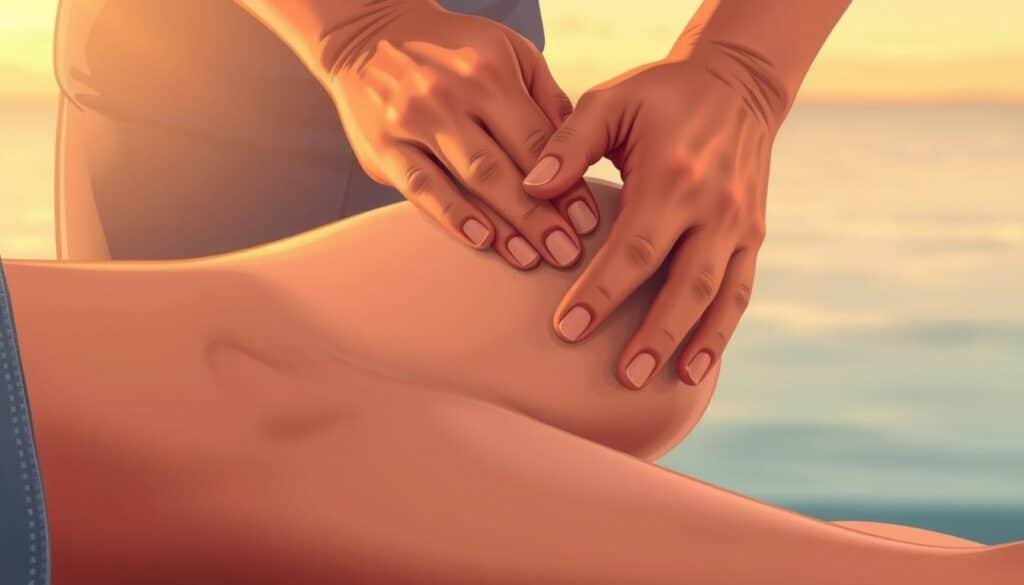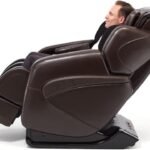Ever wondered why your calves feel like rocks after a long day? Tight calf muscles can be a real pain, quite literally. But what if I told you that relief is just a few simple techniques away? In this guide, I’ll show you how to massage your calf muscle effectively. You can master these methods easily.
Calf muscle massage is a game-changer for relieving tension and discomfort. It’s great for anyone, whether you’re an athlete, office worker, or just someone who spends a lot of time on their feet. I’ll cover easy steps for relieving calf muscle pain, from hands-on methods to using tools.
Ready to say goodbye to tight, achy calves? Let’s dive into the world of calf massage. Discover how you can give your legs the TLC they deserve, right from your own home.
Key Takeaways
- Calf muscle massage helps relieve tension and pain
- Self-massage techniques can be easily performed at home
- Various methods include hand techniques, tools, and electric massagers
- Regular calf massages can improve muscle flexibility and circulation
- Proper technique is crucial for effective pain relief and muscle relaxation
Understanding Calf Muscle Anatomy
Knowing about calf muscle anatomy is crucial for a good massage. The calf has two main muscles. They work together to move your foot and ankle.
Gastrocnemius and Soleus Muscles
The gastrocnemius is the outer, diamond-shaped muscle you can see. It’s key for explosive movements like jumping. The soleus is deeper and helps with endurance activities like standing or walking.
| Muscle | Location | Function |
|---|---|---|
| Gastrocnemius | Outer calf | Explosive movements |
| Soleus | Deep calf | Endurance activities |
Common Causes of Calf Muscle Tension
Calf muscle tightness can come from many sources. Overexertion during exercise, long walks, or activities like climbing and hiking often cause it. Even everyday habits can contribute:
- Wearing uncomfortable shoes
- Poor posture
- Prolonged sitting or standing
Understanding these causes helps me target problem areas during massage. By focusing on both the gastrocnemius and soleus, I can relieve calf muscle tension. This improves overall leg comfort.
Benefits of Calf Muscle Massage

Calf muscle massage has many benefits for your well-being. It keeps my legs feeling good, especially after hard workouts or long days. Regular massages are a must for me.
One key benefit is easing calf muscle pain. Massages apply pressure and work out knots, reducing pain and speeding up recovery. This is great for athletes or anyone who stresses their lower legs.
Massaging your calves also boosts blood circulation. This brings more oxygen and nutrients to your muscles. It’s like a natural energy boost for your legs!
| Benefit | Description |
|---|---|
| Pain Relief | Reduces discomfort and soreness in calf muscles |
| Improved Circulation | Increases blood flow, delivering more oxygen and nutrients |
| Relaxation | Promotes overall relaxation and reduces stress |
| Flexibility | Enhances range of motion in the lower legs |
Another big plus is tackling calf muscle knots. These tight spots can cause pain and limit movement. Massage helps work out these knots, improving flexibility and reducing leg tension.
Lastly, calf massage prevents injuries by keeping muscles loose and flexible. It’s a simple yet effective way to keep your legs healthy and pain-free.
Preparing for Your Calf Massage
Getting ready for a calf massage is important for a good experience. I’ll show you how to prepare, including what supplies you need and how to create a relaxing space.
Necessary Supplies
Here are the basic things you’ll need for a calf massage:
- Massage oil or lotion
- Clean towel
- Comfortable pillow or bolster
- Loose, comfortable clothing
Creating a Comfortable Environment
Make a quiet spot for your massage. Dim the lights and play soft music. Keep the room at a nice temperature. Wear loose clothes or shorts for easy access.
Use a pillow or bolster to support your legs during the massage.
When to Avoid Calf Massage
While calf massages are usually safe, there are times to skip them:
| Condition | Reason to Avoid |
|---|---|
| Suspected blood clots | Risk of dislodging clots |
| Recent injury or surgery | May interfere with healing |
| Painful varicose veins | Can worsen discomfort |
| Decreased leg sensitivity | Difficulty gauging pressure |
If you’re not sure about your condition or have concerns, talk to a healthcare professional first. Following these tips will help you prepare for a safe and effective massage.
How to Massage Calf Muscle: Easy Techniques

I’ve found some great ways to massage your calf muscles. These methods are easy to do at home and don’t need any special tools.
Hand Massage Technique
The hand massage is a good way to start. I use long, gentle strokes to warm up the muscles. This gets them ready for deeper massage and boosts blood flow.
I use my palms to move smoothly over the calf. I go from the ankle up to the knee.
Knuckle Massage Method
The knuckle massage is more intense. I make a loose fist and use my knuckles to knead the muscles. I start behind the shinbone and move towards the back of the leg.
This method targets deeper muscle tissue. It’s great for tight calves.
Circular Motion Massage
The circular motion massage is good for finding tight spots. I use my fingertips to make small circles on the calf. I press and release as I go.
This technique helps me focus on knots or sore spots. It’s very soothing and works well for relaxing the calf.
By mixing these techniques, I’ve made a routine that covers all muscle needs. Start softly and add more pressure if needed. Always pay attention to how your body feels.
Using Tools for Calf Massage

I’ve found that using specialized calf massage tools can greatly enhance my self-massage for calves. These tools allow me to target specific areas and apply varying levels of pressure, making my massages more effective.
Foam rollers are versatile calf massage tools that I use regularly. They’re excellent for covering large areas and can be used while sitting or lying down. For more focused pressure, I turn to massage balls or tennis balls. These smaller tools are perfect for working out stubborn knots in my calf muscles.
Electric massagers have become a game-changer in my calf massage routine. Massage guns deliver rapid, deep tissue massage, while foot and calf massagers provide a relaxing, hands-free experience. Here’s a comparison of these calf massage tools:
| Tool | Pressure Level | Area Coverage | Ease of Use |
|---|---|---|---|
| Foam Roller | Medium | Large | Easy |
| Massage Ball | High | Small | Moderate |
| Massage Gun | High | Small to Medium | Easy |
| Foot/Calf Massager | Low to Medium | Large | Very Easy |
By incorporating these tools into my self-massage routine, I’ve noticed a significant improvement in my calf muscle health and overall leg comfort.
Foam Rolling Techniques for Calf Muscles
Foam rolling for calves is a great way to ease muscle tension and boost flexibility. It’s especially helpful for reaching those tricky spots in your lower legs. Let’s dive into some effective foam rolling methods.
Basic Foam Rolling Method
To foam roll my calves, I sit on the floor with the roller under my lower legs. I use my hands and the opposite foot for support as I roll back and forth. It’s important to move slowly to let the roller work out any tight spots.
I usually spend 30 seconds to 2 minutes on each leg. This ensures I cover both the outer and inner calf muscles.
Targeting Specific Areas
If I hit a sore spot while foam rolling, I stop and hold the pressure for 20-30 seconds. This helps release the tension. I breathe deeply and relax my muscles to get the most out of it.
| Area | Duration | Technique |
|---|---|---|
| Gastrocnemius | 30-60 seconds | Long, slow rolls |
| Soleus | 30-60 seconds | Short, focused rolls |
| Tight spots | 20-30 seconds | Static pressure |
Using these foam rolling techniques has greatly improved my calf flexibility and reduced soreness after workouts. It’s now a key part of my recovery routine.
Tennis Ball and Massage Ball Techniques
Tennis ball calf massage is a game-changer for tight muscles. It’s incredibly effective for targeting specific areas of tension. Plus, it’s simple, affordable, and can be done almost anywhere.
To start, sit on a flat surface and place a tennis ball under your calf. Gently move your body to roll the ball over the muscle. The goal is to apply enough pressure for a deep massage without pain.
If you prefer more intensity, a massage ball for calves is a great choice. These balls are denser and have textured surfaces for a deeper tissue massage.
| Technique | Duration | Pressure | Best For |
|---|---|---|---|
| Side-to-side rolling | 1-2 minutes | Light to moderate | General tension relief |
| Forward-backward rolling | 2-3 minutes | Moderate | Targeting knots |
| Stationary pressure | 30-60 seconds | Firm | Deep tissue release |
It’s important to listen to your body during these sessions. If you hit a sore spot, pause and apply gentle pressure until it eases. This technique has been a lifesaver after long runs or intense workouts.
Remember, consistency is key. Adding tennis ball calf massage to your routine can improve flexibility and reduce muscle soreness over time.
Electric Massagers for Calf Relief
Electric massagers are a great way to ease tired calf muscles. They are perfect for quick relief after workouts or long days on your feet. Let’s look at two popular electric calf massagers that can help you relax and recover.
Massage Guns
A massage gun for calves gives strong, focused relief. I start with the lightest attachment on the lowest setting. Moving the device over my calf muscles for 30-60 seconds is amazing.
Foot and Calf Massagers
Foot and calf massagers offer a calming experience. I set the device at a 45-degree angle and rest my calves on it. A 10-minute session usually makes me feel refreshed.
These machines use kneading, rolling, and heat therapy for full relief.
| Feature | Massage Gun | Foot and Calf Massager |
|---|---|---|
| Portability | High | Low |
| Intensity | Adjustable, high | Moderate |
| Coverage | Targeted | Broad |
| Session Time | 1-2 minutes | 10-15 minutes |
Whether you pick a massage gun for calves or a foot and calf massager, these options can greatly improve your recovery and relaxation. Start gentle and increase intensity as you get used to it.
Post-Massage Care and Stretches
After a relaxing calf massage, I always follow up with proper care. This helps me keep the benefits and avoid tightness. Here’s how I take care of my calves after a massage:
First, I focus on staying hydrated. Drinking lots of water helps get rid of toxins from the massage. I drink at least 8 ounces of water within an hour after.
Next, I let my muscles rest. I avoid hard activities for the rest of the day. This allows my calves to fully recover.
Finally, I do gentle calf stretches. These stretches keep my muscles flexible and prevent tightness. Here are two stretches I love:
- Wall Stretch: I stand facing a wall, place my hands on it, and step one foot back. I lean forward, keeping my back leg straight and heel on the ground. I hold for 30 seconds, then switch legs.
- Seated Towel Stretch: While sitting, I wrap a towel around my foot. I gently pull the towel towards me, keeping my leg straight. I hold for 30 seconds on each leg.
By following these tips and stretches, I’ve seen big improvements in my muscle flexibility and leg comfort. If you have ongoing pain after massage, see a healthcare professional.
Conclusion
I’ve looked into calf muscle massage benefits and self-massage techniques. Knowing your calf muscle anatomy is crucial for a good massage. By learning how to prepare and using different methods, you can reduce tension and boost leg health.
There are many techniques, like hand massages and foam rolling, for everyone. You can also use tools like tennis balls and electric massagers for extra help. Always start slowly and pay attention to how your body feels as you try these methods.
Learning to massage your calf muscles is a great way to handle soreness and tightness. With time, you’ll find the right routine to keep your legs feeling good. If you have ongoing issues, it’s smart to talk to a healthcare professional.
FAQ
What are the benefits of calf muscle massage?
What supplies do I need for a calf massage?
When should I avoid calf massage?
What hand techniques can be used for calf massage?
How can I use a foam roller for calf massage?
How do I use tennis balls or massage balls for calf massage?
How can I use an electric massager for calf relief?
What should I do after a calf massage?
Source Links
- How to Massage a Tight Calf Muscle — Spa Theory – https://www.spatheory.com/spa-theory-wellness-beauty-blog/how-to-massage-tight-calf-muscle
- Calf Massage: 5 Best Techniques for Sore Lower Legs – https://medmassager.com/blogs/articles/calf-massage-techniques?srsltid=AfmBOop7RxVm0Nup1qMIvHU0lK7gmzVzsIKbcKptxXJierfUsvAbJFAg
- How to massage tight calf muscles yourself – myPhysioSA – https://myphysiosa.com.au/how-to-massage-tight-calf-muscles-yourself/













3 Comments
Interesting read, but wouldnt it be more beneficial to include a section on post-massage care for the calf muscle?
Isnt it curious how we often overlook massaging our calf muscles, despite them being key to our mobility? They deserve more attention, dont they?
Absolutely! Our calves are the unsung heroes of our bodies! They deserve a daily massage, no doubt.